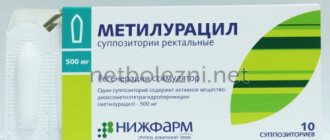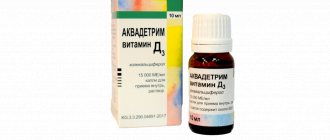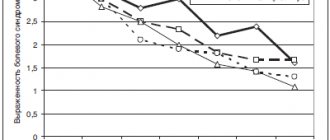Pharmacodynamics and pharmacokinetics
Distreptase suppositories contain 2 active components:
- Streptokinase is a fibrinolytic enzyme that promotes the transfer from the inactive form of the proenzyme plasminogen to its active form - plasmin , aimed at dissolving fibrin fibers of blood clots.
- Streptodornase is a biocatalyst for the dissolution of pus and other dead cells without negatively affecting the integrity and functioning of healthy cells.
Thus, the drug provides access to antibacterial agents directly at the site of inflammation.
Pharmacokinetics have not been studied.
Pharmacological properties of the drug Distreptase
The drug contains two active substances: streptokinase and streptodornase. Streptokinase is an activator of the proenzyme plasminogen contained in human blood, and under the influence of streptokinase it is converted into plasmin, which has the property of dissolving human blood clots. Streptodornase is an enzyme that has the ability to dissolve sticky masses of nucleoproteins, dead cells or pus without affecting living cells and their physiological functions. The drug facilitates the access of antibiotics or chemotherapeutic agents to the site of inflammation.
Distreptase suppositories, instructions for use (Method and dosage)
The instructions for Distreptaza involve the rectal use of Distreptaza suppositories with the deepest possible administration.
The dose is calculated depending on the severity of inflammation. Highlight:
- Severe degree with the prescription of 1 suppository three times a day for 3 days, then 1 suppository twice a day for 3 days, and then 1 suppository once a day for 3 days.
- Moderate and mild severity , in which the following regimens are followed: 1 suppository twice a day for 3 days, then 1 suppository once a day for 4 days or twice a day for 2 days.
Compound
1 suppository contains streptokinase in the amount of 15,000 IU, streptodornase - 1250 IU, in addition there are auxiliary substances in the form of paraffin oil and Witepsol H15.
Release form
Creamy white rectal suppositories weighing 2 g +/- 0.1 g.
pharmachologic effect
Antithrombotic effect.
Pharmacodynamics and pharmacokinetics
Distreptase suppositories contain 2 active components:
- Streptokinase is a fibrinolytic enzyme that promotes the transfer from the inactive form of the proenzyme plasminogen to its active form - plasmin , aimed at dissolving fibrin fibers of blood clots.
- Streptodornase is a biocatalyst for the dissolution of pus and other dead cells without negatively affecting the integrity and functioning of healthy cells.
Thus, the drug provides access to antibacterial agents directly at the site of inflammation.
Pharmacokinetics have not been studied.
Indications for use
Used for acute or chronic adnexitis, salpingitis , endrometritis, postoperative infiltrate , acute or chronic inflammation of hemorrhoidal veins , paraproctitis and fistula, coccyx cyst , to prevent the formation of adhesions after operations in the abdominal cavity, as well as in the pelvic area.
Contraindications
Do not use on fresh wounds or postoperative sutures.
Not recommended for use by children, pregnant or nursing women.
Side effects
Allergy , hyperthermia , risk of bleeding.
Distreptase suppositories, instructions for use (Method and dosage)
The instructions for Distreptaza involve the rectal use of Distreptaza suppositories with the deepest possible administration.
The dose is calculated depending on the severity of inflammation. Highlight:
- Severe degree with the prescription of 1 suppository three times a day for 3 days, then 1 suppository twice a day for 3 days, and then 1 suppository once a day for 3 days.
- Moderate and mild severity , in which the following regimens are followed: 1 suppository twice a day for 3 days, then 1 suppository once a day for 4 days or twice a day for 2 days.
Overdose
There is no information about recorded cases of overdose.
Interaction
The medicine enhances the penetration of antibiotics and other chemicals into the site of inflammation.
Terms of sale
The drug is available by prescription with a dose prescribed depending on the severity of the inflammation.
Storage conditions
In the refrigerator compartment at a temperature of 2-8 degrees Celsius. Freezing is prohibited.
Best before date
Three years.
Attention! The description of the drug on this page is simplified. Before purchasing and using the drug, consult your doctor or pharmacist, and also read the instructions approved by the manufacturer. Information about the drug is provided for informational purposes only and should not be used as a guide to self-medication. ATTENTION! This section is provided for informational purposes only and is not a catalog or price list of our company. To obtain information about the availability of drugs, call + 99871 202 0999 Pharmacy Network Helpline 999.
Analogs
Level 4 ATC code matches: Biostrepta
Actilyse
Gemaza
Fibrinolysin
Thrombovazim
Streptokinase
- Aktilise
- Biostrepta
- Metalize
Indications
Based on the research results, it was concluded that Distreptase is a safe and effective medicine. It is used to treat the following diseases:
- chronic salpingitis;
- chronic adnexitis;
- chronic salpingoophoritis;
- postoperative infiltrative processes in the pelvis;
- adhesions in the abdominal cavity after surgery or inflammatory diseases;
- follicular ovarian cysts;
- swelling in diseases of the pelvic organs;
- endometritis;
- acute and chronic hemorrhoids;
- abscesses and fistulas in the anus and rectum with extensive inflammation;
- inflammation of the tissue surrounding the rectum;
- purulent caudal (lower spine) cysts.
Distreptase price, where to buy
The price ranges from 1400 to 1600 rubles for 6 suppositories in a blister. The price of Distreptase suppositories is indicated taking into account the dosage of 15,000 IU + 1,250 IU; one course of treatment usually lasts on average 7 to 10 days and requires from 8 to 18 suppositories.
You can buy candles in Moscow at almost any pharmacy; use search engines to find out availability and prices.
- Online pharmacies in RussiaRussia
- Online pharmacies in UkraineUkraine
- Online pharmacies in KazakhstanKazakhstan
LuxPharma* special offer
- Dystreptase suppositories rect.
2g N6 3100 rub. order
show more
Pharmacy24
- Dystreptase 2 g N6 suppositories Biomed-Lublin Witturnia Surowiec i Szczepionek Spulka Akcijna, Poland
374 UAH.order
PaniPharmacy
- Dystreptase suppository Supp.dystreptase rect. 2g No. 6 Poland, Biomed-Lublin
406 UAH order
show more
Dystreptase rectal suppositories 15000IU+1250IU No. 6x1
Name
Dystreptase supp. rect. 15000IU+1250IU per bl. in pack №6x1
Description
Physico-chemical properties Suppositories in the form of cones or “torpedoes” with a pointed end, without mechanical damage; color from white to cream*; It is allowed to have inclusions of a darker color distributed throughout the mass of the suppository, as well as unevenness and depressions at the base of the suppository.
Main active ingredient
Streptokinase+streptodornase
Release form
rectal suppositories
Dosage
15000 iu+1250 iu 2 g
Indications for use
DYSTREPTASE® in the form of suppositories is used in adults as part of complex therapy in the following cases: 1. Chronic salpingoophoritis. 2. Postoperative infiltrative changes. 3. Endometritis. 4. Hemorrhoids with acute and chronic course. 5. Perirectal abscesses and fistulas with extensive inflammatory infiltrate. 6. Purulent caudal cysts. The effectiveness of DYSTREPTASE® in inflammatory diseases of the pelvic organs in women has not been demonstrated in placebo-controlled randomized trials. The use of the drug is based on experience in clinical use.
Directions for use and doses
After removing the suppository from the blister cell, it must be inserted deep into the rectum. The dosage depends on the type and intensity of the inflammatory process. Use as directed by your doctor. In case of severe disease in adults: 1 suppository 3 times a day for the first 3 days; 1 suppository 2 times a day for the next 3 days; 1 suppository 1 time per day for the next 3 days. For mild to moderate severity of the disease in adults: 1 suppository 2 times a day for 3 days; 1 suppository 1 time a day for the next 4 days, or 1 suppository 2 times a day for 2 days. On average, 8–18 suppositories are used per course of treatment. The average duration of treatment is 7 - 10 days. All unused remains of the medicinal product, as well as its waste, should not be disposed of in the sewer or with household waste. These measures will help protect the environment. Instructions for disposing of unused medicine can be obtained from your pharmacist.
Precautionary measures
Features of the use of the drug by certain categories of patients (children, pregnant or breastfeeding women, elderly people, patients with certain types of pathologies) The drug DISTREPTAZA® should not be used by pregnant women, or during breastfeeding. There are no data regarding the specifics of use in persons with impaired liver and kidney function, as well as in elderly patients. Data on the safety and effectiveness of the drug in pediatric practice are limited, therefore its use in children under 18 years of age is not recommended.
Interaction with other drugs
DYSTREPTASE® should not be used concomitantly with anticoagulants because local bleeding may occur. If you are taking other medications, be sure to tell your doctor!
Contraindications
Hypersensitivity to any component of the drug, hemorrhagic diathesis, early period after surgery on the pelvic and rectal organs. The drug should not come into contact with a fresh wound covered with scab, as well as with a freshly applied suture, as this can cause relaxation of the sutures and, as a result, hemorrhage from the wound.
Compound
Streptokinase Streptodornase 15000 IU ± 10% 1250 IU – 20000 IU Active substances Liquid paraffin (Paraffin oil) 0.16 g Excipient Neutral fat Witepsol H15 1.84 g Excipient
Overdose
There are no known symptoms of overdose.
Side effect
Sometimes allergic reactions, increased body temperature and a tendency to bleed may occur. If any atypical reactions occur, stop using the drug and be sure to consult your doctor about the possibility of continuing to use the drug!
Storage conditions
The place for storing the medicine should be inaccessible and invisible to children. Store at a temperature of 2oC - 8oC (in the refrigerator). Do not freeze. Shelf life: 3 years.
Distreptaza
According to statistics, inflammatory diseases of the pelvic organs (inflammation of the ovaries, uterus, prostate gland, etc.) are the most common problem for patients of reproductive age (from 16 to 49 years1). Such diseases are very insidious and dangerous with the risk of developing such serious complications as: infertility, ectopic pregnancy, menstrual dysfunction, adhesive disease, chronic pelvic pain. If inflammation does occur, the approach to choosing treatment should be professional, balanced and comprehensive. The treatment regimen includes: from the first days of therapy to restore blood circulation, increase the concentration of antibacterial drugs at the site of inflammation, enhance and accelerate the relief of the inflammatory process and prevent the formation of adhesions 2,3,4 - drugs containing streptokinase (for example, Dystreptase suppositories); if a pathogen is identified, antibacterial drugs are used. Immunomodulators, desensitizing drugs, symptomatic therapy (antispasmodics, analgesics), and drugs to restore vaginal microflora in women are also used2.
Distreptase is an enzyme preparation that contains a fibrinolytic - streptokinase (15,000 IU) and a proteolytic - streptodornase (1,250 IU). Distreptase has an anti-inflammatory effect, improves microcirculation in the site of inflammation, relieves swelling, significantly increases the concentration of antibacterial drugs and immune cells in the site of inflammation, accelerates the lysis of dead cells (pus) and their reabsorption (removal, cleansing) from the site of inflammation, without affecting, but preserving healthy tissue 3,4,6. Pain and dysuric phenomena (frequent, painful urination, false urge to urinate) are relieved 2.5-3 times faster. When using the drug Distreptaza in the treatment regimen, signs of inflammation according to ultrasound data are eliminated faster, the length of hospital stay is reduced by 5 days, and repair processes are accelerated 3 times 2,4,5,6,12.
It is very important that the use of the drug Distreptaza reduces the risk of disease relapse, infertility or the development of adhesive disease 2,4-6. Thus, the inclusion of the drug Distreptase makes it possible to increase the effectiveness of treatment to 96-98%2,4,5,6.
Distreptase is successfully used for the treatment of gynecological and urological pathologies, in proctology, in dermatovenerology, and in the postoperative period in surgical practice 6-9,12. Dystreptase has proven itself not only in the complex therapy of inflammation, but also in the treatment of male and female infertility, ovarian cysts, early rehabilitation after an abortion or after a terminated pregnancy, after operations in the abdominal cavity and pelvis to eliminate inflammatory and adhesive manifestations 6-9. Dystreptase is used as monotherapy to relieve aseptic inflammation and reduce pain in the treatment of chronic pelvic pain and adhesions10,11.
Dystreptase – treatment of inflammation, adhesive disease, infertility.
Dystreptase rectal suppositories No. 6: Witturnia Surowicz and Szczepionek Spulka Akciyna (Poland), RK-LS-5 No. 121670
*Information for medical and pharmacy specialists for use in professional activities. Before use, read the instructions. Keep out of the reach of children. 1. Women's health. Fact sheet N°334. Updated September 2013, https://www.who.int/mediacentre/factsheets/fs334/en/ 2. Order of the Ministry of Health of Ukraine dated December 27, 2011 No. 977 “On amendments to the order of the Ministry of Health of Ukraine dated December 15, 2003 No. 582 “On approval clinical protocols for obstetric and gynecological care." Order of the Ministry of Health of Ukraine No. 431 dated 07/03/06. Clinical protocol for providing medical care for chronic prostatitis. 3. Instructions for medical use of the drug Distreptaza. 4. V.A.Potapov et al. Dystreptase is a new solution to the problem of pathogenetic correction of the inflammatory response and circulatory disorders of the pelvic organs in women with exacerbation of chronic salpingoophoritis, Women's Reproductive Health No. 4 (38). 2008. 5. V.A. Potapov et al. Strategy for early postoperative rehabilitation of reproductive function in women with uterine leiomyoma. Women's health, No. 10 (76), 2012. 6. B. M. Ventskovsky et al. Modern tactics for the treatment of chronic inflammatory diseases of the pelvic organs in the acute stage (methodological recommendations). Ministry of Health of Ukraine, 2009. 7. E.A. Litvinets et al. Treatment of men with excretory toxic infertility caused by chlamydial infection. Men's health, No. 1, 2012. 8. T.I. Tamm et al. Local treatment of surgical wounds in patients with acute paraproctitis with the drug Distreptaza., Men's Health, No. 3, 2012. 9. S.M. Onishchenko et al. Long-term results of surgical treatment of acute adhesive intestinal obstruction. Men's health, No. 3, 2012. 10. I.Z. Gladchuk et al. Prevention of adhesions after surgical treatment of infertile women with uterine fibroids and endometriosis. Women's reproductive health, 35 (39), 2008. 11. O.Yu. Shcherbak et al. The use of Distreptase in the complex treatment of patients with dysuria after surgery for prostate hyperplasia. Men's health, No. 4, 2009. 12. A.Ya. Senchuk et al. Optimization of treatment of patients with salpingoophoritis and menstrual dysfunction in women of reproductive age. Women's Health. 2012; 10(76): 1-8.
men, No. 4, 2009
Newspaper “News of Medicine and Pharmacy” 8(242) 2008
Inflammatory diseases of the pelvic organs not only remain leaders in the structure of gynecological diseases, but also have fatal consequences for women’s reproductive health, thereby creating medical, social and economic problems.
The incidence of infertility in women who have suffered one episode of inflammatory diseases of the pelvic organs is about 18%, and after three episodes reaches 50% (Breeding D., 1997, Reyes I., 2006). The main cause of infertility in such cases is adhesions and fibrous changes in the ovaries that form even after a single inflammation. In this regard, increasing attention is being paid to finding optimal ways to solve problems associated with the consequences of inflammation.
Antibacterial, anti-inflammatory, antimycotic and immunomodulating drugs are used to treat chronic inflammatory diseases of the pelvic organs. Enzymes and agents that improve microcirculation are of great importance in the treatment of such patients. For resorption therapy, enzymatic preparations and biostimulants are most often used, the effectiveness of which is insufficient.
In September 2007, a new drug for resorption therapy, Dystreptase, appeared on the Ukrainian pharmaceutical market. A conference organized by Alpen Pharma GmbH, held in Donetsk, in the restaurant of the Victoria Hotel on April 1, 2008, was devoted to the experience of using the drug in obstetric and gynecological practice. The product manager of the company, Victoria Samsonova, spoke about the effect of the drug. The complex drug Distreptase, produced in Poland and used for the treatment of inflammatory diseases of the pelvic organs, appeared on the Ukrainian market in September 2007. It is produced in the form of rectal suppositories, each of which contains an original combination of active substances - streptokinase 15,000 IU and streptodornase 1250 IU, as well as auxiliary substances that facilitate the absorption and entry of the active components into the blood and lymphatic channels of the pelvic organs.
Streptokinase, as a basic thrombolytic drug, is successfully used in surgery and cardiology in the treatment of extrapelvic thrombosis, although its doses are significantly higher. Streptodornase is an endonuclease enzyme. It dissolves the intermolecular bonds of nucleoproteins of dead cells and pus, facilitates the resorption of oligoproteins, activates phagocytosis without affecting the structure and function of healthy cells. The mechanism of action of Distreptase is based on a unique combination of active components of the drug, which causes rapid lysis of necrotic masses, fibrin deposits and blood clots, which leads to the dissolution of adhesions. The drug is recommended from the first days of the inflammatory process, acts on all phases of inflammation and prevents the development of adhesions. The course of treatment is 7–10 days. Dystreptase is a unique, the only drug in Ukraine for absorbable therapy for inflammatory diseases of the pelvic organs in women of any age category, at any period of the disease. The drug is also widely used in proctology, urology and dermatovenerology.
An assessment of the effectiveness of complex therapy for chronic inflammatory diseases of the uterine appendages using the drug Distreptaza was presented in the report of Associate Professor Sergei Viktorovich Kushnir (Institute of Emergency and Reconstructive Surgery of the Academy of Medical Sciences of Ukraine named after V.K. Gusak). Inflammatory diseases of the uterine appendages make up 82% of other inflammatory diseases, 7% of them are complicated forms. The purpose of the study was to determine the effectiveness of the proposed complex therapy for patients with chronic inflammatory disease of the uterine appendages using the drug Distreptaza. 64 patients made up the control group, 70 - the main group. The criteria for assessing the effectiveness of the proposed therapy were a clinical trial questionnaire and quality of life parameters. The questionnaire included a pain scale, data from general and gynecological examinations, general urine analysis, bacterioscopic examination of a smear from the cervical canal and vagina, ultrasound of the uterus and appendages, duration of treatment, complications of the disease. Assessment of the effectiveness of treatment based on quality of life included physical and mental state, social and role functioning, and general subjective perception of one’s health. Analysis of the study led to the conclusion that the use of the drug Distreptaza in the complex treatment of chronic inflammatory diseases of the uterine appendages allows reducing the treatment time for this group of patients, improving the immediate results of treatment, which ultimately affects the quality of life, since it does not force changes in everyday roles and patients' usual social activity.
The report of Associate Professor Elena Nikolaevna Nosenko (Research Institute of Medical Problems of the Family, Department of Obstetrics, Gynecology and Perinatology of the Donetsk National Medical University named after M. Gorky) presented modern tactics for managing functional ovarian cysts in reproductive age. According to various sources, ovarian masses occupy 2nd place in the structure of all tumors of the genital organs, and 2nd–3rd place in the structure of urgent gynecological pathology. Over the past two decades, the incidence of ovarian tumors among gynecological patients has increased from 6–7 to 19–25%. 75–87% of all ovarian masses are benign. In turn, among benign ovarian formations, 75–80% have a cystic structure.
The incidence of functional ovarian cysts is 60–73%. Functional ovarian cysts are of particular interest, since it is precisely with this form of cystic tumor-like formations of the ovaries, the most common in gynecological practice, that it is possible to carry out conservative medical or minimally invasive surgical treatment, including transvaginal needle aspiration drainage with sclerotherapy and cystectomy. Abundant blood supply and tissue looseness of functional ovarian cysts in one third of patients lead to internal hemorrhages into the lumen of the cyst with the formation of a hematoma, accompanied by pain. Functional ovarian cysts with persistence for more than 2 months have practically no receptors for steroid hormones and are insensitive to hormone therapy. Such cysts can develop significant changes in the form of cellular and nuclear polymorphism. Sclerosis develops in the surrounding ovarian tissue due to compression, impaired circulation and trophic processes.
Distreptase was included in the complex therapy of functional ovarian cysts, including hormonal drugs, immunomodulators, a complex of antihomotoxic drugs, 30% sodium thiosulfate solution IV 10 ml every other day No. 10: 3 days, 3 suppositories per day, 3 days, 2 suppositories candles, 3 days, 1 candle. Active follow-up was carried out for 2 months. When using Distreptase, rapid lysis of blood clots was achieved, improvement of blood circulation and microcirculation in the cyst walls, leading to an increase in the concentration of drugs in the cyst wall and ovary, rapid elimination of infiltration and clinical manifestations of inflammation in the ovary, which subsequently prevents the development of adhesions. The absorbable, fibrinolytic and proteolytic effect of Dystreptase is due to the combination of two active substances - streptokinase and streptodornase. Streptokinase activates the proenzyme plasminogen, which turns into plasmin, which dissolves blood clots, that is, it has a fibrinolytic effect. Streptodornase is a deoxyribonuclease enzyme that leads to the destruction of DNA in the intestinal wall, resulting in deep depolymerization, the “bridges” of nucleoproteins of dead cells dissolve, the resorption of dead cells and oligoproteins is facilitated, and phagocytosis is activated. In the presence of streptokinase and streptodornase, the concentration of phagocytes increases significantly, their mobility improves, and the percentage of completed phagocytosis increases, as a result of which we can achieve regression of the cyst. Regression of formation after treatment was observed in 57% of cases. Thus, as a result of the study, it was revealed that the inclusion of Dystreptase in the treatment regimen for functional ovarian cysts reduces the duration of pain by 2.3 times, the time of cyst resorption by 1.5 times, and in the presence of intracavitary hematoma - by 2.6 times.
During surgical treatment, Distreptase was included in the complex of postoperative measures after 7 days according to the same scheme. The drug is highly tolerable and safe to use. Dystreptase is especially indicated after gynecological operations in women planning pregnancy and wishing to preserve reproductive function.
Alpen Pharma GmbH has initiated a clinical multicenter post-marketing study to evaluate the effectiveness, safety and tolerability of Dystreptase in the complex treatment of inflammatory diseases of the pelvic organs, in which doctors from gynecological centers in Kiev, Donetsk, Kharkov, Dnepropetrovsk, Lvov and Odessa are participating. Gynecologists from Donetsk who also took part in this conference are participating in the study: Voronina Olga Vladimirovna, Kalinovskaya Natalia Evgenievna, Kim Tatyana Horimovna, Popandopulo Alla Dmirievna, Borlova Larisa Aleksandrovna, Tretyakova Larisa Anatolyevna, Omelchenko Natalia Aleksandrovna, Kasyanova Natalia Vasilievna, Azokhova Olga Nikolaevna, Ivanova Tatyana Aleksandrovna, Rastorgueva Elena Georgievna, Kuznetsova Ilona Anatolyevna, Grigoryan Armina Yuryevna, Pavlova Evgenia Viktorovna, Pomelnikova Yulia Andreevna, Taran Natalia Andreevna, Kipiani Maya Vitalievna, Portvenko Andrey Vitalievich, Prezdnyakova Adiliya Faridovna , Filatova Yulia Grigorievna, Petrenko Tatyana Gennadievna, Listratenko Olga Petrovna, Khancha Fedor Aleksandrovich, Yudina Andriana Sergeevna, Sigareva Victoria Aleksandrovna, Ostapenko Tatyana Mikhailovna, Pilipets Valentina Andreevna, Kaverina Victoria Alekseevna.
You will get acquainted with the data obtained as a result of the study and reviews of doctors about the use of the drug in the following publications of our publication.
Prepared by Tatyana Brandis
Note!
The description of the drug Distreptase on this page is a simplified author’s version of the apteka911 website, created on the basis of the instructions for use.
Before purchasing or using the drug, you should consult your doctor and read the manufacturer's original instructions (attached to each package of the drug). Information about the drug is provided for informational purposes only and should not be used as a guide to self-medication. Only a doctor can decide to prescribe the drug, as well as determine the dose and methods of its use.
Contraindications
Increased sensitivity to the composition of the drug.
The medication should not come into contact with a wound covered with fresh scab or with a fresh suture, as this may cause relaxation of the sutures and, as a result, bleeding.
Not used to treat people with bleeding disorders.
Not prescribed for children.
Not used during pregnancy and lactation.
Anticoagulants and calcium supplements can be combined with Distreptase strictly under the supervision of a specialist.




